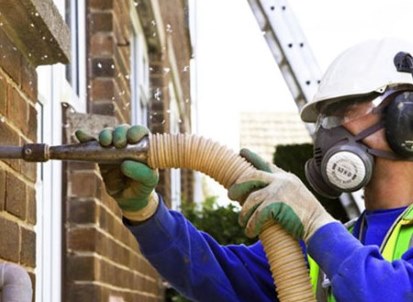Call us on 01422 880100
Which materials are used to insulate walls?

You’ve read about the benefits of insulating your house, but which materials will actually be going on or into your walls?
We explore the properties of different types of wall insulation:
External wall insulation
External wall insulation is connected to the outside of a property and is made up of four layers:
1. Primer
- Prepares the walls for insulation
- Contains abrasive quartz crystals to help the insulation stick
- Biocide products can be added to remove and prevent biological growth on the walls
- Covers small cracks and creates a firm surface for the insulation layer.
2. Insulation layer
The main insulation – usually expanding polystyrene or mineral wool. This is usually fastened to the property’s exterior through self-tapping screws:
| Expanding Polystyrene | Mineral Wool |
|---|---|
|
|
3. Glass fibre mesh
- Designed to add strength, flexibility and binding to the insulated wall
- Installed on top of the insulation boarding and underneath the final render
- Applied by sinking into adhesive mortar which is then smoothed over
4. Render finish
- The final layer with a decorative function
- Available in different finishes and colours (including smooth silicone, pebble dash and brick slip effect), enabling you to improve and enhance the look of your home
Internal wall insulation
There are two options for insulating a solid wall internally:
Stud wall
A metal or wooden studwork frame is attached to the wall and filled in with mineral wool fibre. It can then be plastered over and finished with paint or wallpaper.
This type of insulation:
- Is thicker than rigid insulation boards, so could reduce the size of your rooms more than other systems
- Is strong enough to hold heavy fittings such as: kitchen units, radiators or sinks
- Can be a better option if the wall surface is uneven
- Requires the mineral wool filling to be at least 120mm thick
- Can even be covered with rigid insulation boards (instead of plaster) to reduce energy loss even further.
Rigid insulation boards
Plasterboard backed with rigid insulation material – usually foamed plastic – is fixed straight onto the interior wall surface. Extra fixings hold the boards in place and the joints are sealed to prevent air leakage.
This type of insulation:
- Is normally 60-100mm thick, so will take up less space than stud wall insulation
- Requires the wall surface to be level before boards are fitted
- Is more effective than mineral wool insulation.

Cavity wall insulation
As the name suggests, cavity walls lend themselves to be filled.
There are three common options for cavity wall insulation materials:
- Blown mineral fibre
- Polystyrene beads or granules
- Urea formaldehyde foam
| Insulation Type | Method |
|---|---|
| Blown Mineral Fibre | Strands of fibreglass or mineral wool are blown into the cavity using compressed air. This is the most common type of cavity wall insulation. |
| Polystyrene beads or granules | Small pellets are pumped into the cavity using compressed air. They will either stick together by themselves (granules) or have sticky resin added (beads). |
| Urea formaldehyde foam | Two chemical components simultaneously mixed and injected into the cavity, instantly expanding to fill it. This technique is used in hard-to-treat or uneven cavities that are not suitable for more traditional wall insulation methods. |
Considerations that should be made before proceeding with any cavity wall insulation include:
- All walls must be inspected for suitability first
- Cavities must be at least 50mm wide
- PVC-covered electrical cables should be removed before installation.
T: 01422 880100 (office hours: 9am - 5pm, Mon - Fri)
Or Contact Us
Share this story
Related Services
Related Articles
Is my home suitable for Cavity Wall Insulation?
Technitherm Cavity Wall Insulation FAQs
What is Technitherm Cavity Wall Insulation?
External Wall Insulation Vs Internal Wall Insulation
External Wall Insulation – A Simple Guide
Funding Options & Grants for External Wall Insulation
External Wall Insulation FAQs
Properties Suitable for External Wall Insulation
Cavity Wall Insulation or External Wall Insulation?
How is External Wall Insulation Installed?
Who We Help
Grants & Advice
Find out more about saving energy and the funding opportunities available.
